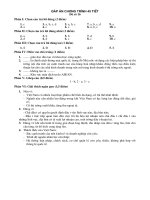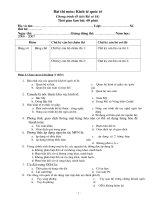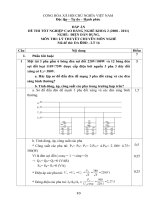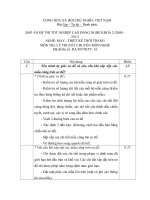PASSAGE 16
Bạn đang xem bản rút gọn của tài liệu. Xem và tải ngay bản đầy đủ của tài liệu tại đây (37.25 KB, 2 trang )
PASSAGE 16
Probably the most famous film commenting on the twentieth-century technology is Modern Times, made
in 1936. Charlie Chaplin was motivated to make the film by a reporter who, while interviewing him,
happened to describe the working conditions in industrial Detroit. Chaplin was told that healthy young
farm boys were lured to the city to work on automotive assembly lines. Within four or five years, these
young men’s health was destroyed by the stress of work in the factories.
The film opens with a shot of a mass of sheep making their way down a crowded ramp.
Abruptly, the film shifts to a scene of factory workers jostling one another on their way to a factory.
However, the rather bitter note of criticism in the implied comparison is not sustained. It is replaced by a
gentle note of satire. Chaplin prefers to entertain rather than lecture.
Scenes of factory interiors account for only about one-third of Modern Times, but they contain some of
the most pointed social commentary as well as the most comic situations. No one who has seen the film
can ever forget Chaplin vainly trying to keep pace with the fast-moving conveyor belt, almost losing his
mind in the process. Another popular scene involves an automatic feeding machine brought to the
assembly line so that workers need not interrupt their labor to eat. The feeding machine malfunctions,
hurling food at Chaplin, who is strapped in his position on the assembly line and cannot escape. This
serves to illustrate people’s utter helplessness in the face of machines that are meant to serve their basic
needs.
Clearly, Modern Times has its faults, but it remains the best film treating technology within a social
context. It does not offer a radical social message, but it does accurately reflect the sentiment of many
who feel they are victims of an over-mechanised world.
Question 1. According to the passage, Chaplin got the idea for Modern Times from ______.
A. a movie
B. a conversation
C. a newspaper
D. fieldwork
Question 2. The young farm boys went to the city because they were ______.
A. promised better accommodation
B. driven out of their sheep farm
C. attracted by the prospect of a better life
D. forced to leave their sheep farm
Question 3. The phrase “jostling one another” in the third paragraph is closest in meaning to “______”.
A. jogging side by side
B. pushing one another
C. hurrying up together
D. running against each other
Question 4. According to the passage, the opening scene of the film is intended ______.
A. to reveal the situation of the factory workers
B. to introduce the main characters of the film
C. to produce a tacit association
D. to give the setting for the entire plot later
Question 5. The word “vainly” in the fourth paragraph is closest in meaning to “_______”.
A. recklessly
B. carelessly
C. hopelessly
D. effortlessly
Question 6. According to the author, about two-thirds of Modern Times ________.
A. entertains the audience most
B. is rather discouraging
C. was shot outside a factory
D. is more critical than the rest
Question 7. The author refers to all of the following notions to describe Modern Times EXCEPT
“_________”.
A. satire
B. entertainment
C. criticism
D. revolution
Page 1
ĐÁP ÁN
1-B
2-C
6-C
7-D
3-B
4-C
5-C
LỜI GIẢI CHI TIẾT
Question 1:
Đọc đoạn thứ nhất, ta có thể thấy ý t ưởng của bộ phim là từ cuộc hội thoại (conversation) khi Charlin nói
chuyện với phóng viên. Trong đo ạn đầu có câu: “Charlie Chaplin was motivated to make the film by a
reporter who, while interviewing him, happened to describe the working conditions in industrial Detroit.”
Động từ motivate nghĩa là động cơ, trong ngữ cảnh này chính là khơi ngu ồn cảm hứng làm bộ phim
Modern Times.
Question 2:
Đọc đoạn thứ nhất, ta thấy câu: “healthy young farm boys were lured to the city to work on automotive
assembly lines.” Động từ lure = attract chia ở bị động tức là bị cuốn hút, lôi kéo. Chúng ta có thể thấy
rằng, young farm boys ra thành phố bởi họ hi vọng có cuộc sống tốt đẹp hơn
Question 3:
jostling one another nghĩa là xô đẩy lẫn nhau, vậy đáp án B: pushing one another là gần nghĩa nhất
Question 4:
Cảnh đầu của bộ phim l à “mass of sheep making their way down a crowded ramp” có tác dụng ngụ ý (ẩn
ý) về hình ảnh những cơng nhân nh à máy. Vì vậy đáp án đúng là B, tacit nghĩa là ngụ ý, ẩn ý
Question 5:
Các trạng từ effortlessly (một cách dễ dàng), recklessly ( một cách thiếu thận trọng), hopelessly (tuyệt
vọng), carelessly (một cách bất cẩn), vainly có nghĩa là vơ ích, vơ vọng, vì vậy từ gần nghĩa nhất với nó là
phương án C hopelessly
Question 6:
Chừng 2/3 bộ phim được quay bên ngoài 1 nhà máy
Question 7:
Đoạn cuối có câu:“ It does not offer a radical social message” vì vậy nó khơng có ý revolution
Page 2









